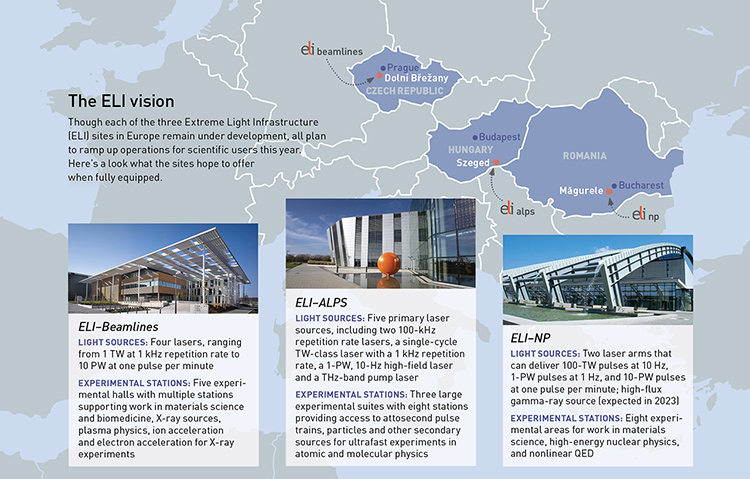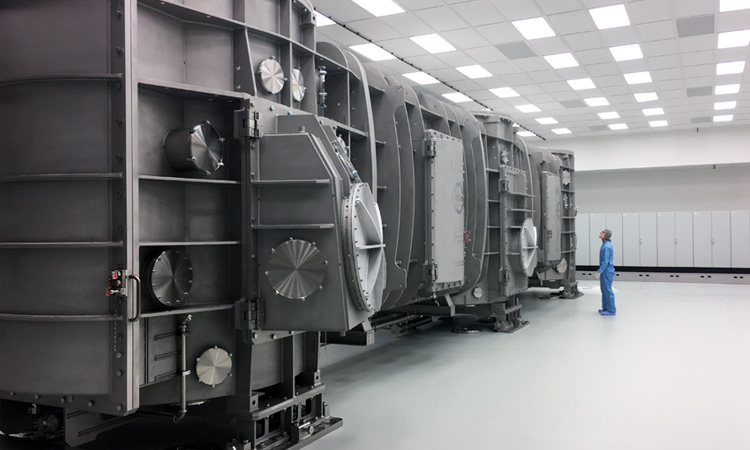 Scientist Štěpán Vyhlídka next to the railroad-car-sized pulse compressor for the Aton 10-petawatt laser, ELI–Beamlines facility, Dolní Břežany, Czech Republic. [Courtesy of ELI–Beamlines]
Scientist Štěpán Vyhlídka next to the railroad-car-sized pulse compressor for the Aton 10-petawatt laser, ELI–Beamlines facility, Dolní Břežany, Czech Republic. [Courtesy of ELI–Beamlines]
On a brisk day in Prague in October 2009, three Central European countries—the Czech Republic, Hungary and Romania—launched toward an audacious goal. At a meeting that day, the countries’ governments received the official all-clear from representatives of the European Commission (EC) and 13 partner nations to raise three state-of-the-art user facilities that would sport the most powerful lasers ever built.
As a new decade dawns, the facilities are preparing to throw their doors open to scientific users, and to start realizing ELI’s ambitious agenda of discovery.
Resting on a commitment of some €850 million (some US$935 million at today’s exchange rates) to fund the facilities’ construction, this “Extreme Light Infrastructure” project—ELI, for short—sought to take laser fields to extremes that would drive basic and applied science to unimagined new heights. The atmosphere crackled with ideas about what these beefy new lasers could enable, ranging from advances in proton therapy and nuclear-waste management, to exotic experiments to “boil” the quantum vacuum and reveal new physics.
In the intervening ten years—even as Europe as a whole has endured sovereign-debt crises, the rise of populism and the drawn-out political drama of Brexit—planning, design and construction of the three ELI sites has continued. And as a new decade dawns, the facilities are preparing to throw their doors open to scientific users, and to start realizing ELI’s ambitious agenda of discovery. To kick off this 60th anniversary year of the laser’s birth, OPN here looks at the ELI project’s status and what the next few years could hold.
From one facility to three
The ELI idea was hatched a few years before the Prague meeting, when the European laser science community got the project onto the roadmap of the European Strategy Forum for Research Infrastructure (ESFRI). This EU program provided more than €6 million for a three-year preparatory phase, ELI–PP, that would start in November 2007 and would involve 13 countries and more than 50 laboratories. ELI–PP would suss out the technical and safety requirements and site selection for a facility centered around “an exawatt-class laser” that would deliver pulses “at least 100 times more powerful than any other existing or planned.”
Initially, ELI–PP envisioned all of this power centered in a single location. But while five EU countries—France, the United Kingdom, and the then recently admitted Central European states of the Czech Republic, Hungary, and Romania—all put proposals on the table to host such a behemoth, those one-country plans choked on the huge cost, then estimated at some €600 million.
Then the three Central European states offered an alternative. Instead of a single, big-ticket facility, each of the three countries would host a smaller site that included lasers capable of up to 10 petawatts (PW) in peak power, and that focused on a specific piece of the science case for these intense lasers. The siting and funding of a fourth planned facility, or “pillar,” of ELI, centered around a 200-PW “exawatt-class” laser, would be decided later.
The plan had some definite political and financial advantages, according to Allen Weeks, the director general of the ELI Delivery Consortium (ELI–DC), an organization that coordinates the three ELI sites’ development activities. For one, the three countries could cover the steep construction costs by drawing on so-called structural funds from the European Regional Development Fund (ERDF), an EU money pot for infrastructure investments to benefit new or less advantaged EU member countries.
ERDF “was dramatically expanded when a number of the Central European countries joined the EU in the mid-2000s,” Weeks notes, and the funds “were mainly intended for developmental projects like bridges and roads and schools and hospitals.” But the three countries vying for ELI facilities took advantage of an increasing trend to allow ERDF funding to extend to research infrastructure. “The idea,” says Weeks, “was that in this way, they could develop the scientific communities and technical capabilities of these countries—recognizing that science, as well as bridges, is an important part of development.”
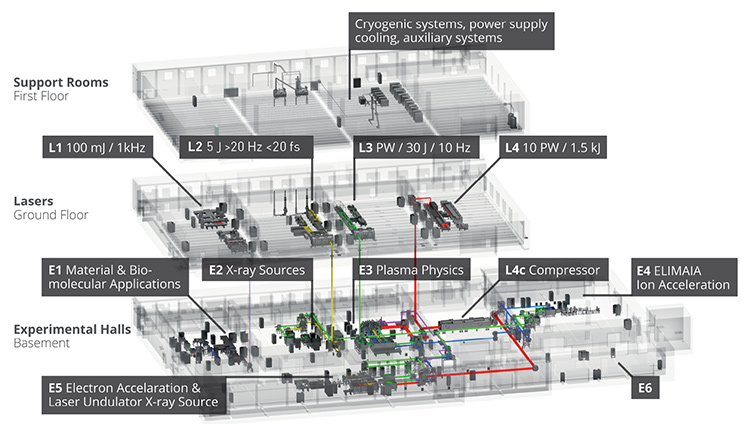 While the three ELI facilities look at different problems, they have a number of systems in common: High-peak-power lasers; experimental areas where the laser energy, in different combinations, drives scientific experiments; and beam-distribution systems to get the beams from point A to point B. At ELI–Beamlines (shown here), the experimental areas and the lasers are on different floors; in the other ELI facilities; they are on the same level. [Courtesy of ELI–Beamlines] [Enlarge image]
While the three ELI facilities look at different problems, they have a number of systems in common: High-peak-power lasers; experimental areas where the laser energy, in different combinations, drives scientific experiments; and beam-distribution systems to get the beams from point A to point B. At ELI–Beamlines (shown here), the experimental areas and the lasers are on different floors; in the other ELI facilities; they are on the same level. [Courtesy of ELI–Beamlines] [Enlarge image]
ELI–Beamlines: A menu of secondary sources
With the funding model in place, the Czech Republic’s ELI–Beamlines—the first of the sites to actually break ground—began construction in 2012 in the Prague suburb of Dolní Břežany, on land adjacent to an existing industrial-laser research facility, HiLASE.
ELI–Beamlines focuses on one of the superpowers of petawatt-class lasers: their use to create high-energy radiation and particle streams for experiments in pure and applied science. As ultrashort, high-peak-power laser pulses with intensities greater than 1020 W/cm2 strike gas or solid targets, the concentrated electromagnetic fields can rip electrons out of their orbits, creating plasmas that give rise to streams of soft and hard X-rays, accelerated ions and other beams. These “secondary source” beams, in turn, enable experiments in biomedicine and materials science, plasma wakefield acceleration, laboratory astrophysics and other areas, in five experimental halls in the ELI–Beamlines basement.
The energy to create these secondary sources falls to four laser systems. The L1 Allegra, built in-house, is a high-repetition-rate, terawatt-scale light source, designed to produce a thousand sub-20-fs pulses of 100 mJ energy per second. Right now, the Allegra runs at around 30 mJ, with a 14-fs pulse width. The first user experiments with the laser have already commenced, including “about 20 campaigns” at four stations in the facility’s E1 experimental hall this past summer, according to Roman Hvězda, a deputy director of the Czech Institute of Physics responsible for ELI–Beamlines.
The second Beamlines laser, the L2 Amos, is currently being built, using a 10-J laser head made by Rutherford Appleton Lab, U.K., as the pump system. Targeted for completion in 2021 or 2022, Amos will produce pulses of 100 TW at a 50-Hz repetition rate, to drive a free-electron laser to be built in one of the experimental halls.
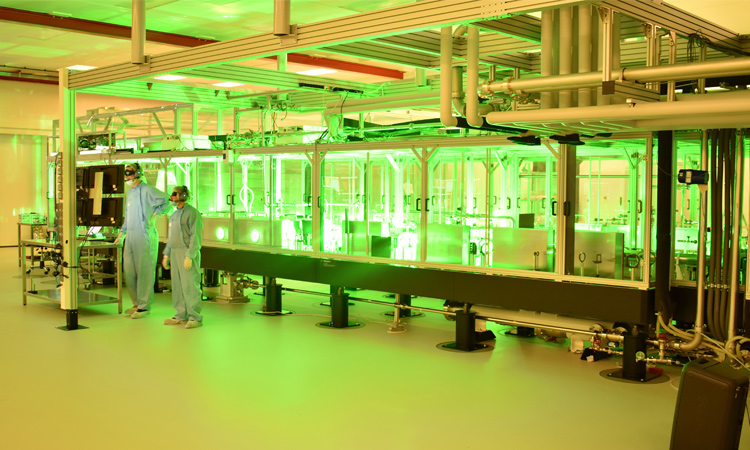 The 1-PW, 10-Hz HAPLS laser, from Lawrence Livermore National Laboratory, USA, was installed and integrated at ELI–Beamlines in mid-2018, and has since been used in demonstration ion-acceleration experiments. [LLNL]
The 1-PW, 10-Hz HAPLS laser, from Lawrence Livermore National Laboratory, USA, was installed and integrated at ELI–Beamlines in mid-2018, and has since been used in demonstration ion-acceleration experiments. [LLNL]
Petawatt-class lasers
Next in peak power is the L3 laser, the High-Repetition-Rate Advanced Petawatt Laser System (HAPLS), developed and built for ELI–Beamlines at the Lawrence Livermore National Laboratory (LLNL) in the United States, with the vacuum pulse compressor built by ELI–Beamlines. The L3 HAPLS, a new-generation diode-pumped beam amplified in a three-stage, Ti:sapphire-based CPA system, was installed at the Czech facility in 2018, with the first shot in June of that year. Eventually it will churn out petawatt pulses at a 10-Hz repetition rate; it’s now said to be routinely running for users and to have shown good results in early proton-beam acceleration experiments.
The most muscular Beamlines laser, designed to produce one 10-PW pulse per minute, is the L4 Aton beam, built in collaboration with the U.S. firm National Energetics and the Lithuanian laser manufacturer Ekspla. The flashlamp-pumped Aton uses OPCPA to preamplify a millijoule-scale seed pulse to the 5-J level, and then beefs up the pulse energy to 1.5 kJ in a mixed Nd:glass amplifier.
The Aton laser has demonstrated operation at energies exceeding 1.5 kJ in the output beam and is functioning well, according to Tyler Green, a senior researcher at ELI–Beamlines who took OPN on a tour of some of the site’s lasers last fall. The work now focuses on perfecting the compressor that will take the chirped pulses in the laser’s 65×65-cm beam down to 150-fs-wide pulses containing 10 PW of peak power. The compressor itself is a vacuum unit 18×4×3 m in size—so large that occupies a separate room one floor below the laser hall. “It’s like a train car,” Green said. “It’s really huge.” Work on the compressor—which, to accommodate the beam size and energy, relies on very large, 850×700-mm multilayer dielectric gratings manufactured by LLNL—should be completed in the coming months, with 10-PW output from the L4 laser expected in late 2020.
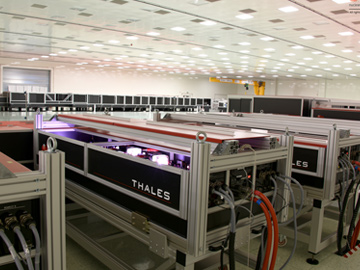 The laser arms built for ELI–NP by the French company Thales are, at present, the most powerful operational lasers in the world. [Courtesy of ELI–NP]
The laser arms built for ELI–NP by the French company Thales are, at present, the most powerful operational lasers in the world. [Courtesy of ELI–NP]
ELI–NP: Probing QED’s mysteries
Around 1100 km southeast of ELI–Beamlines lies another of the three ELI sites, ELI Nuclear Physics (ELI–NP). Construction started in mid-2013 on land just outside of Bucharest, Romania, in the town Măgurele, which already hosts several Romanian nuclear-engineering and atomic-physics labs. That’s a good fit for ELI-NP, which aims to use light from its two 10-PW laser arms both for practical problems in nuclear medicine and nuclear-waste management, and to probe a variety of heretofore inaccessible problems in nuclear physics and strong-field quantum electrodynamics (QED).
To achieve those goals, ELI–NP will combine 10-PW laser pulses with radiation from another cutting-edge light source, a high-intensity gamma-ray beam being designed and built for the same site. “Normally light doesn’t interact with light,” notes Dan Stutman, the head of research activity for ELI–NP, but “that’s not the case if you intersect a bright gamma beam with a very intense laser. Then, you can begin to probe the physics of the quantum vacuum—the photons begin to ‘feel’ the electron–positron pairs in the vacuum.”
For the laser half of this one-two punch, ELI–NP relies on two laser arms designed and built by the French firm Thales. Those two light sources passed a major milestone in commissioning runs during spring 2019, when both reportedly fired off pulses of greater than 10 PW. For the time being, at least, that makes the two lasers at ELI–NP the most powerful lasers in the world.
For the time being, at least, the two lasers at ELI–NP are the most powerful lasers in the world.
After an OPCPA preamplification stage to ensure sharp temporal contrast and filter out noise, pulses in the two laser arms pass through three separate Ti:sapphire amplifiers, each of which successively increases the energy of the initial 10-mJ pulse. For the last of those stages—which boosts pulse energy to more than 320 J before compression—Thales used a Ti:sapphire crystal an unprecedented 200 mm in diameter. “It’s the biggest ruby in the world,” says Stutman. “I wish I had one.”
Compressors at the end of each amplification stage allow the laser arms to produce pulse streams of 25-fs width or less at three peak powers: 100-TW pulses at 10 Hz; 1-PW pulses at 1-Hz; and 10-PW pulses at one pulse per minute. (The 10-PW compressor includes huge, fragile gratings 1.2 m in size.) Those beams will pass through a beam-transport system, still being completed, that will shunt the laser energy in high vacuum to the facility’s three large experimental areas for interaction with solid and gas targets to probe questions in laser-driven nuclear physics and strong-field QED.
Gamma-beam delays
The other half of the ELI–NP concept—the high-energy gamma beam—has had a more difficult history. As has been widely reported, an international consortium agreed in 2014 to build the gamma source, but the contract ran into legal disputes and was canceled by ELI–NP at the end of 2018. That left one of the two anchors of the facility’s science case under a cloud.
The good news, ELI–NP officials say, is that in early October 2019 they inked a contract with a different firm, Lyncean Technologies in Fremont, CA, USA, for the gamma source. Lyncean reportedly plans to build the system by combining elements of two of the company’s existing product lines, a miniature source of synchrotron X-rays for the academic market and an extreme-ultraviolet (EUV) source that it’s building for the semiconductor industry. The result, according to Lyncean, will be a tunable gamma-ray source capable of reaching energies ranging from 1 to 19.5 MeV, with a very small spot size and a very high, near-continuous gamma-ray flux. It’s expected to be installed in stages in the next two years, made operational by 2022 and put into user service beginning in 2023.
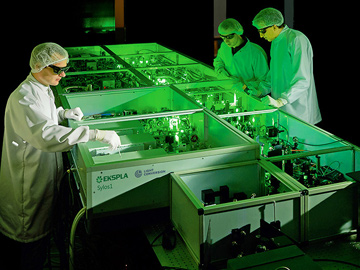 Technicians work on the SYLOS laser of ELI–ALPS, built by the Lithuanian firms Ekspla and Light Conversion. [Ekspla]
Technicians work on the SYLOS laser of ELI–ALPS, built by the Lithuanian firms Ekspla and Light Conversion. [Ekspla]
ELI–ALPS: Pushing attosecond science
The third ELI facility to start construction, the ELI Attosecond Light Pulse Source (ELI–ALPS), saw work begin in 2014 at an old Soviet-era military base in the southern Hungary city of Szeged—around midway between the other two ELI sites. As the name implies, ELI–ALPS would use five laser sources, operating in the near-infrared to terahertz range and at different repetition rates, to create extremely short, single or few-cycle pulses. Those pulses, in turn, would interact with gases or condensed matter to create still shorter, attosecond-scale EUV pulses to be used in pump–probe experiments for investigating electron motion in chemical reactions.
Though the last of the facilities to start construction, ELI–ALPS was the first to bring one of its lasers online. A mid-infrared source that produces 0.15-mJ, sub-40-fs pulses at a repetition rate of 100 kHz became operational in October 2017 and, according to conference presentations, was available for experiments in early 2018. That has been followed by other laser systems, including SYLOS, a terawatt-class, single-cycle machine developed by the Lithuanian firms Ekspla and Light Conversion. Operational since May 2019, SYLOS is capable of pushing out pulses with energies of greater than 30 mJ and durations shorter than 6.5 fs, at a 1-kHz repetition rate.
Two other lasers—a high-rep-rate machine targeting sub-7-fs, 1-mJ pulses at 100 kHz, and a high-field machine aiming at petawatt-scale pulses at 10 Hz—are said to be operational and expected to reach design specs between the second and fourth quarters of 2020. Still other lasers are in development, including a terahertz pump laser designed to enable a high-energy beamline for studies of materials in extreme THz fields.
The menu of different rep rates and intensities is important, as the raison d’être for ELI–ALPS is to push the envelope on energy and repetition rate for attosecond-length, EUV pulses. To get there, light from the various beams will be routed to three large experimental areas, each with a different level of radiation shielding. The beams will interact with gas or solid targets to create streams of attosecond pulses via gas or surface-plasma high-harmonic generation, as well as other secondary particles and beams, for studies of ultrafast atomic or molecular physics, imaging, radiobiology and more.
The facility reportedly created its first attosecond pulses this past June, and there is no shortage of ideas on how to use them or the other capabilities promised by ELI–ALPS. One particularly well-publicized experiment, led by 2018 Nobel laureate and OSA Fellow Gérard Mourou, would use the SYLOS laser to accelerate deuterium nuclei to 100 keV, and test whether such accelerated particles could be used to “transmute” spent nuclear waste to safe radiation levels.
Ramp-up challenges
While the ELI sites have already accomplished some impressive engineering, a different kind of challenge now awaits: transitioning the sites to facilities ready to handle the flow of scientific users lining up to take advantage of them. All three facilities hope to ramp up user operation for laser experiments during the coming year.
Part of the ramp-up challenge still relates to engineering—for example, finishing the beam-transport systems that will carry the intense laser energy to the experimental areas where the science will actually happen, and making the multiple experimental halls and stations themselves user-ready. Beam transport in particular carries formidable technical challenges To avoid self-focusing and beam destruction, the beams must travel through tubes maintained at a very high vacuum. They also need a super-clean environment, since outgassing from even a tiny stray droplet of oil, for example, could coat or destroy the transport system’s extremely expensive optics. “We’re strict about cleanliness,” Tyler Green of ELI–Beamlines said, “and we’re extra strict about vacuum cleanliness.”
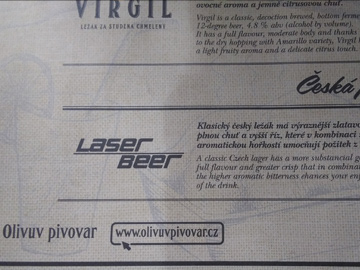 Near the ELI–Beamlines and HiLASE facilities, an enterprising pivovar (brewery) offers locally crafted “Laser Beer.” [Stewart Wills]
Near the ELI–Beamlines and HiLASE facilities, an enterprising pivovar (brewery) offers locally crafted “Laser Beer.” [Stewart Wills]
Getting this infrastructure right is essential, because the ability to combine multiple types of beams to drive new experiments lies at the heart of why ELI exists in the first place. “This is one of the things that often gets lost in the story of ELI,” in the view of Allen Weeks of ELI–DC. “Any of the facilities, by itself, is already world class in this niche of laser research; the sources are already some of the best in the world. It’s the ‘Swiss Army Knife factor’—the combination of those systems, and how you can use all the different lasers, the primary sources in addition to the secondary sources—that’s the unique advantage of ELI.”
Beyond basic engineering, the transition to user facilities will also test things on the project-management and customer-service side. For Roman Hvězda at ELI–Beamlines, one challenge will involve balancing continued, necessary facility development and commissioning with user support. “We need to integrate everything,” he says, “to the level of effective and safe operation for the users.”
For this reason, notes Tyler Green, the team at the facility has focused particularly on system reliability, to ensure that users get the beams they need when they need them. “Lasers are drama queens,” says Green. “It’s really difficult to get them to work and do what you want consistently … so we’ve spent a lot of time on controls for these systems, to make sure their output remains the same day after day.”
From ELI-DC to ERIC
Ramping up to user operation will also bring changes to ELI’s broader governance structure. As the facilities are now “at the cusp of going into operation,” explains Allen Weeks, the funding model will shift from one emphasizing EC structural funds to one where funding derives from member countries in the ELI consortium.
That shift, says Weeks, necessitates formation of a new entity—known, under EU law, as a European Research Infrastructure Consortium, or ERIC—to provide a permanent legal structure for ongoing operations and operational funding for the facilities. An ERIC is “a little bit lighter than a full-blown, international-treaty-based organization” (like the one, for example, governing the CERN facility in France), according to Weeks, “but still has some of the benefits of that.”
Amid the twists and turns, the staff and potential users of the ELI sites are keeping their eyes on the scientific prize.
In November 2019, an application to form such an ERIC was submitted to the European Community. For the time being, however, such an ELI ERIC will include only the Czech and Hungarian facilities, with the Romanian site’s inclusion put on hold pending resolution of the issues surrounding the gamma-ray source. The hope, according to Weeks, is that when the Romanian site is “up to speed and ready to be presented to users,” it can join the ELI ERIC at a later date. “Because there’s a very strong scientific case for ELI–NP,” says Weeks. “It’s going to be combining nuclear science with laser science, creating all kinds of interesting things.”
Indeed, amid the twists and turns, the staff and potential users of the ELI sites are keeping their eyes on the scientific prize. “There’s never really been a user facility based on lasers at this scale—there’s not really, in the world, such a thing,” says Weeks. And while that certainly raises challenges, he adds, it also offers opportunities to use the sites as a launch pad for taking laser science still further, and for making lasers a more central part of work in other disciplines like chemistry and materials science.
Dan Stutman at ELI–NP, meanwhile, thinks the capabilities enabled by the project will push the boundaries of a discipline closer to home. “I have a hunch that there is going to be new physics coming out of this,” he says. “We are knocking at corners in nature where we’ve never knocked before.”
Stewart Wills is OPN’s senior editor.

